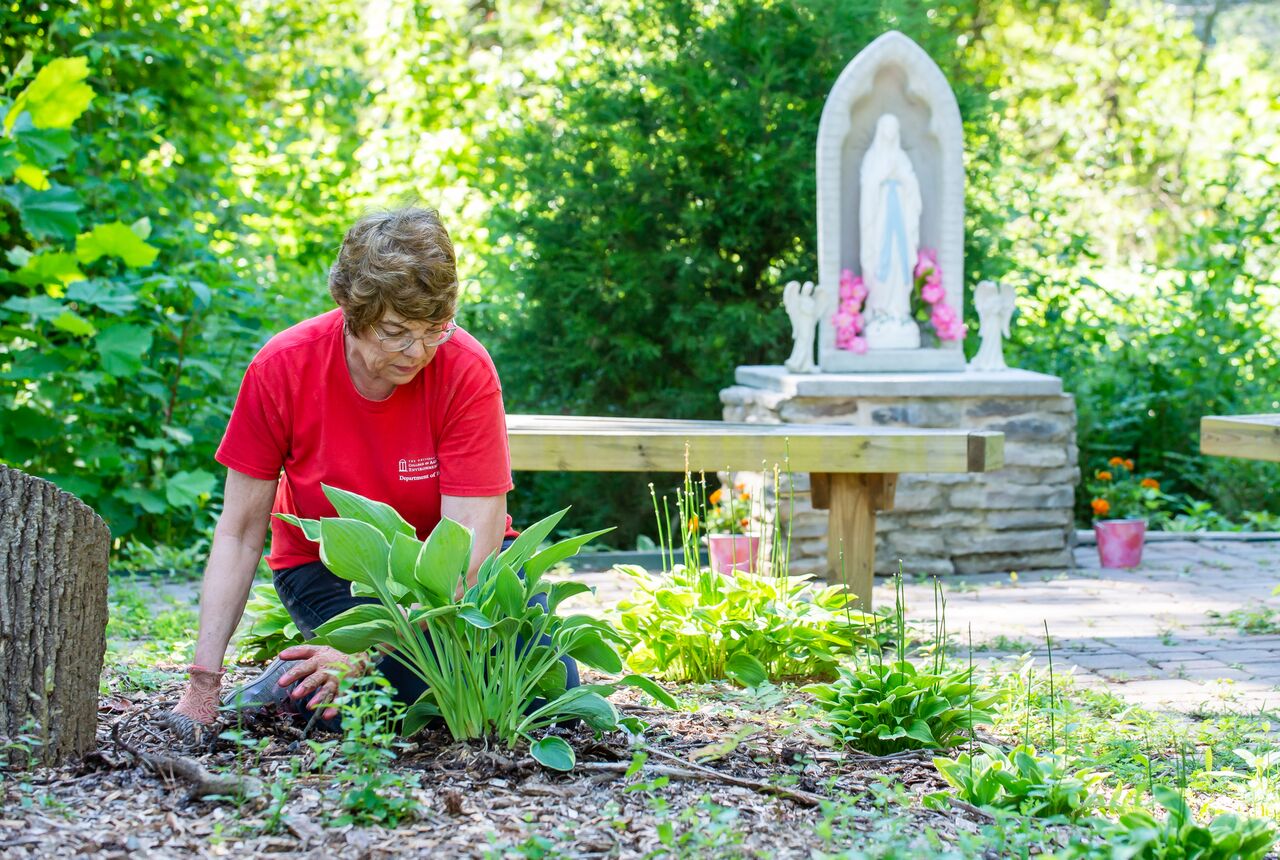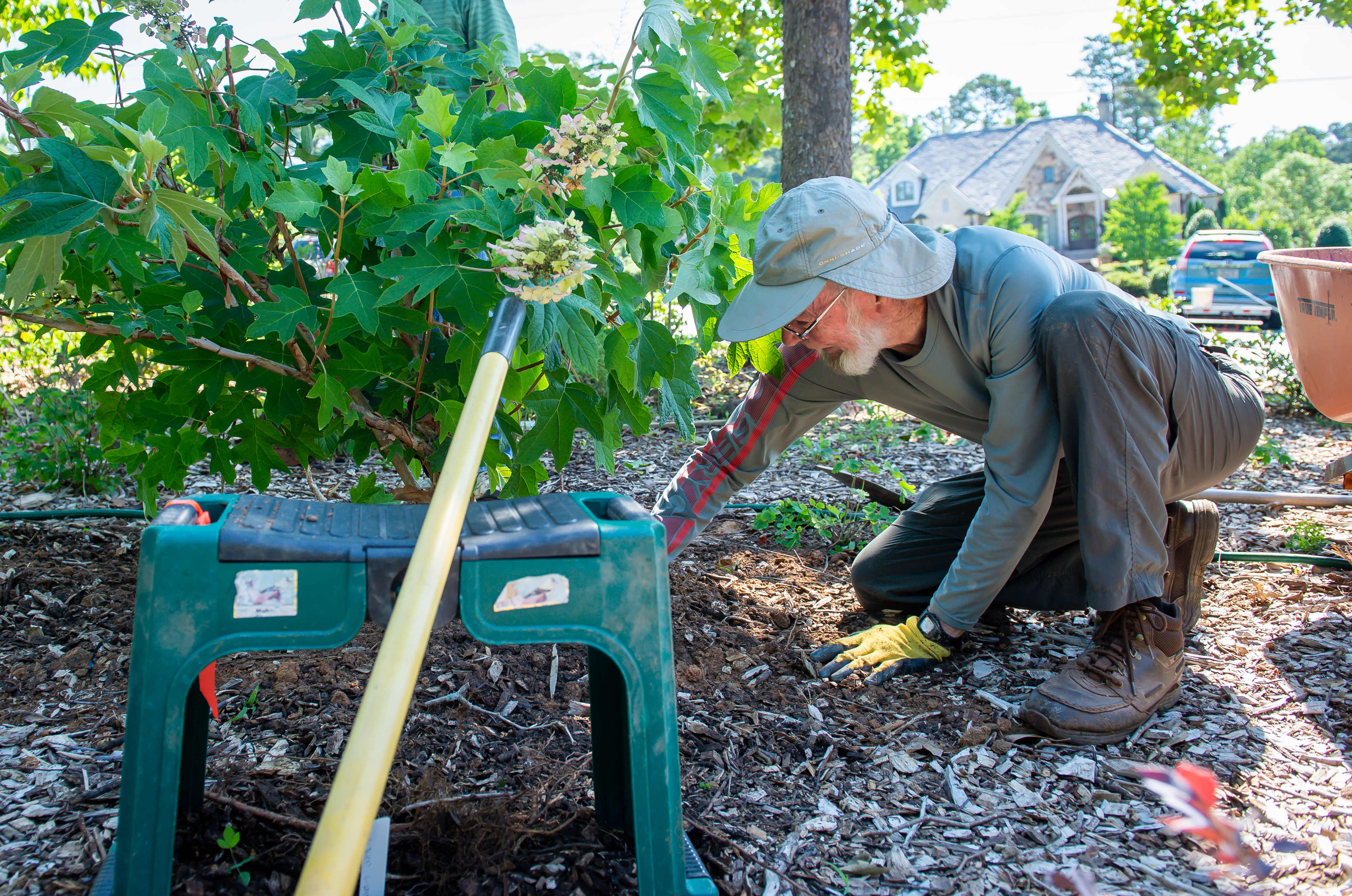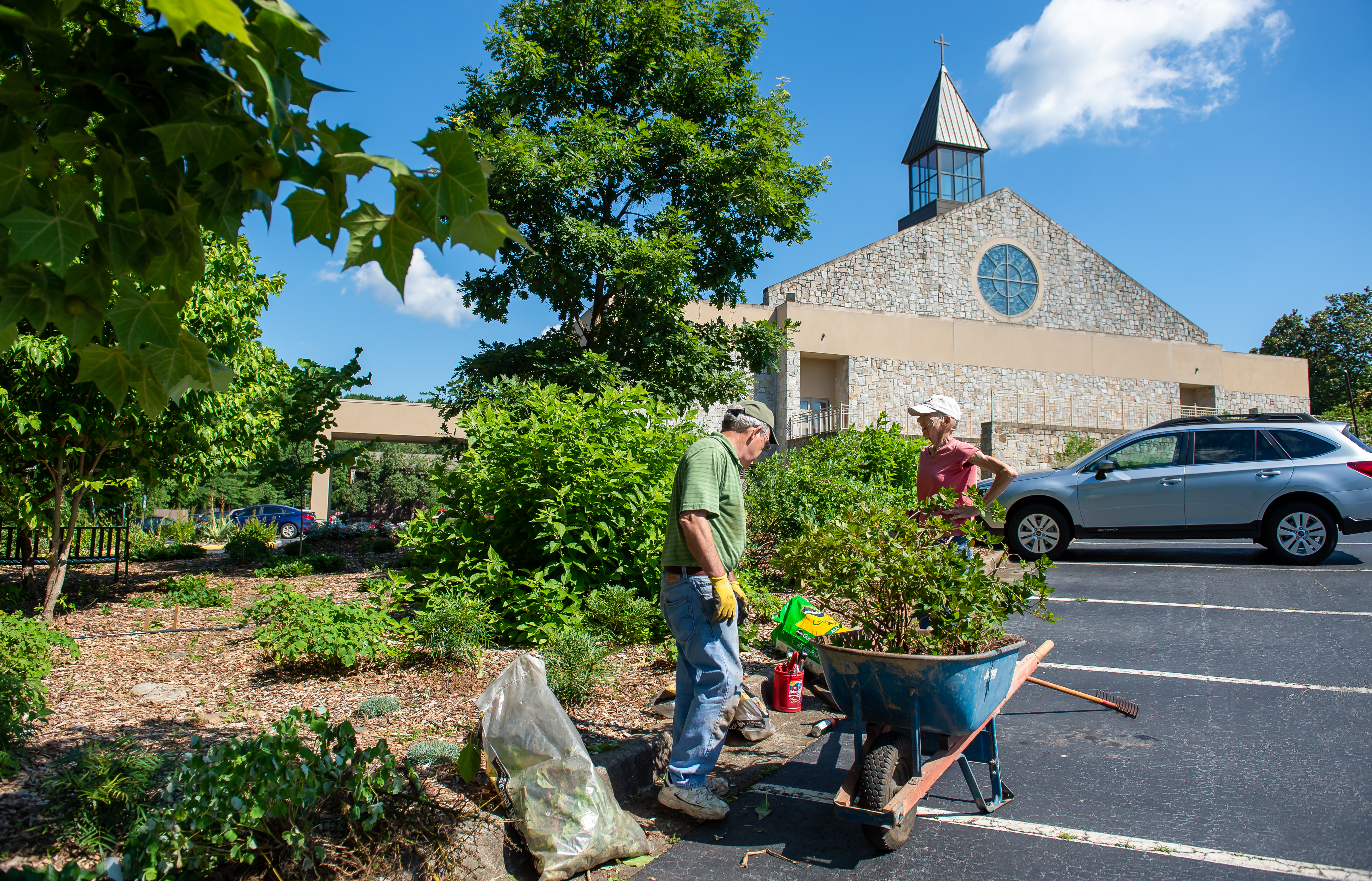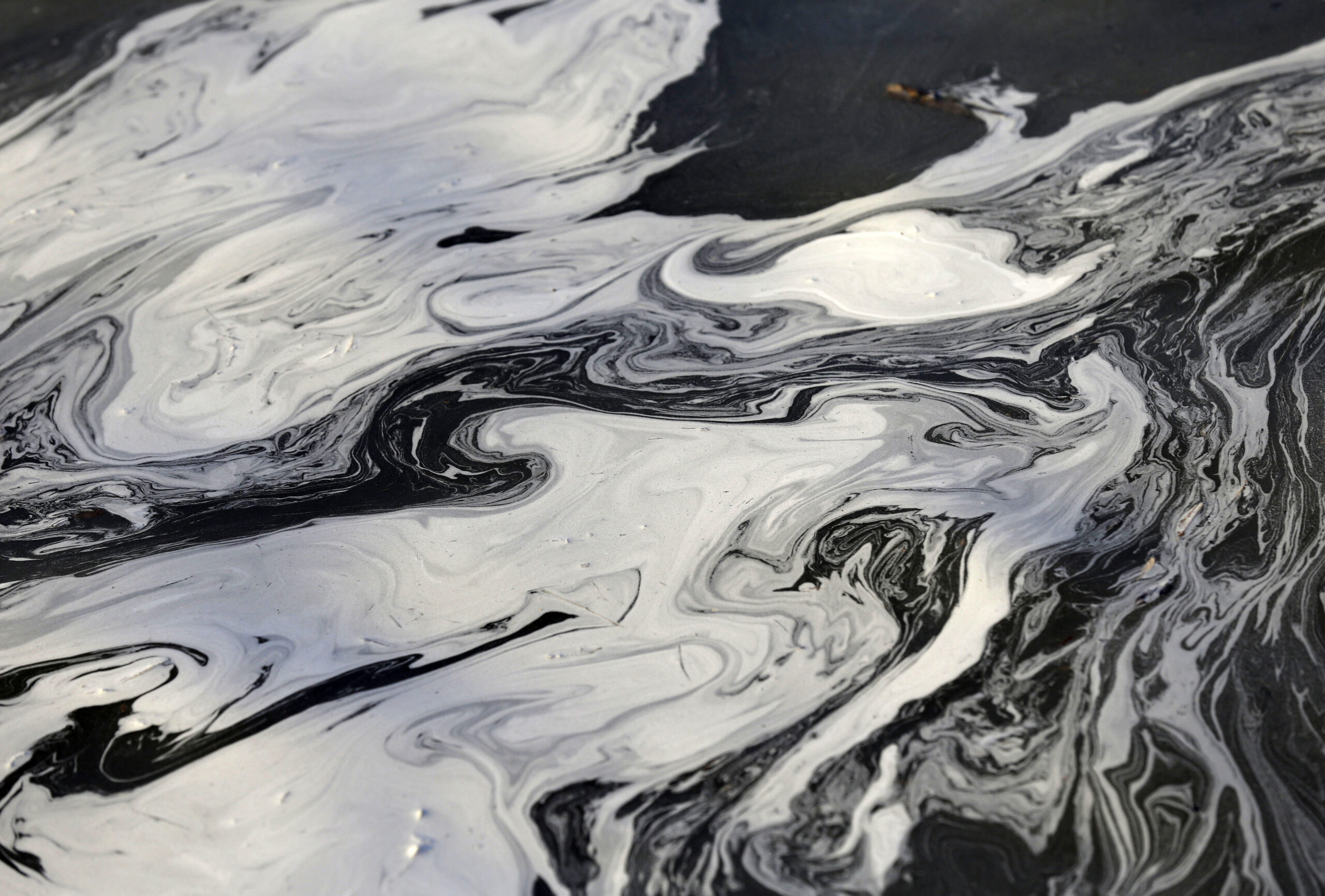Atlanta Seen As A Leader In Catholic Response To The Pope’s Environmental Message

St. John Neumann Catholic Church in Lilburn has responded to Pope Francis’ environmental message. In fact, according to the Archdiocese of Atlanta, St. John Neumann is a model care for creation parish. Many would like to see other parishes also focus more on the environment.
Bita Honarvar / WABE
On a hot Saturday morning, Susan Varlamoff pulls weeds at her church. A parishioner at St. John Neumann Catholic Church in Lilburn, she’s in the woods behind the parking lot, yanking aggressive shrubs out from between the trees.
Varlamoff is here on this garden work day with dozens of other parishioners. They’re weeding a colorful bed of wildflowers and spreading mulch along a forest trail that features the Stations of the Cross. One brave volunteer is pulling up poison ivy.
“It’s a small army of people that have dedicated their morning to getting this work done, and it’s made a huge difference,” Varlamoff says.
Response To The Pope’s Message
Varlamoff chairs the creation care team at her church, and she’s the retired director of UGA’s College of Agricultural and Environmental Sciences Office of Environmental Sciences, so when she found out a few years ago that Pope Francis was writing about the environment, she says she knew she could help in some way.
“I went through the roof,” she says. “I was so excited.”
Laudato Si was released the summer of 2015.
The pope came out with his message. We responded.”
Susan Varlamoff
In the encyclical, Pope Francis writes about air and water pollution, the loss of wildlife and climate change. He writes about humans’ responsibility to care for God’s creation. And how people – especially poor people – are affected by environmental degradation. He asks all people – not just Catholics – to enter into a dialogue about what he calls the “environmental crisis.”
That all spoke to Varlamoff.
“The pope came out with his message. We responded,” she says.
With help from colleagues at UGA, she co-wrote a Laudato Si action plan for the Archdiocese of Atlanta. The plan is full of recommendations for parishes and parishioners, from recycling, to supplying electric car-charging stations at churches, to political advocacy.
“Through the power of the pulpit, the pastor speaking to their people, we feel we can create tremendous momentum,” Varlamoff says.
At St. John Neumann, in addition to working on the gardens, the church got an energy audit and switched to LED light bulbs. They’re now expecting to save thousands of dollars a year on their energy bill. They’re cutting back on Styrofoam use. The pastor talks about the environment from the pulpit.

According to the Archdiocese of Atlanta, St. John Neumann is a model care for creation parish.
And nationwide, the Archdiocese of Atlanta has been recognized for its Laudato Si action plan, the one Varlamoff helped create.
“I think Atlanta is pretty extraordinary,” says Dan Misleh, director of Catholic Climate Covenant, a U.S.-based advocacy group.
Good Efforts In Places
There are other dioceses doing similar work.
The Diocese of Stockton has long focused on environmental justice, and the Archdiocese of Cincinnati has a climate change task force. The Catholic bishops of California released a pastoral statement on the fourth anniversary of Laudato Si, calling on Catholic institutions, public officials and business leaders, among others, to take action on climate change and other environmental issues.
“I can’t imagine there’s a diocese out there that hasn’t done anything. Particularly if you get down to the parish level,” Misleh says.
Summing up the response to Laudato Si from the Catholic Church in the U.S., he says generally it’s been good.
“It could be better for sure, but I do think that it has captured the attention of an awful lot of people,” he says.
And that is more or less the assessment from others, too: There are good efforts in places. The encyclical spoke to people who were eager to hear it, but more could be happening.
In Other Places, More Lukewarm Response
“Overall, the U.S. church still has a long way to go,” says Marisa Vertrees, organizing director of the Global Catholic Climate Movement. She says a lot of people have not read Laudato Si, and the Catholic Church in the U.S. hasn’t prioritized it.
Overall, the U.S. church still has a long way to go.”
Marisa Vertrees
Vertrees contrasts action in the U.S. to Ireland – granted, a smaller and more Catholic country – but one where both the country’s government and the country’s bishops decided to stop investing in fossil fuel companies. There has not been a unified response from the Catholic Church in the U.S. on that level.
There are a few reasons. Pastors are busy; they have a lot of responsibilities, and bishops may hesitate to ask them to take something else on. Politically, the church has focused on other issues: Immigration, religious freedom bills, abortion. The sex abuse scandals have taken a lot of energy and attention.

And last, Vertrees says, the Catholic Church in the U.S. is big, with a wide diversity of opinions.
“The church is divided the way the country is divided,” she says. “And so you see some places where they’re reluctant to take this on as an issue and some that push back on taking it on as an issue.”
One of those people who doesn’t want to take it on is Father Robert Sirico, a pastor in Michigan and the president of the Acton Institute, a libertarian religious think tank.
Sirico agrees that the response to Laudato Si has been lukewarm in the United States, “and with that, I’m content,” he says.
He says he doesn’t disagree with the moral element of the pope’s message, that the Earth is our home, and we have a responsibility to care for it, but he says the Vatican should stay out of environmental policy.
I don’t think the church needs to become Greenpeace.”
Father Robert Sirico
“The church exists to proclaim the Gospel of Jesus Christ, and when all these other kinds of political and temporal concerns blot out that message, the church loses herself,” he says. “I don’t think the church needs to become Greenpeace. I think we have some very serious issues in the Catholic Church, and I don’t see this question of environmental activism as being at the top of that list.”
‘A Guiding Light’
But for people who do want to see action, there’s more that could be happening.
“Pope Francis was very bold in publishing Laudato Si,” says the Rev. Kate MacGregor Mosley, executive director of Georgia Interfaith Power and Light, which works with faith communities on environmental issues, including providing grants to Catholic parishes for energy upgrades.
“I would say we have not shown up with the bold action that is required to address climate change today,” she says.
Mosley is Presbyterian, not Catholic, but she says Laudato Si was inspiring to people across faiths.
I would say we have not shown up with the bold action that is required to address climate change today.”
the Rev. Kate MacGregor Mosley
The Rev. Dr. Gerald Durley agrees.
A retired pastor, veteran of the civil rights movement and board member of Georgia Interfaith Power and Light, Durley calls the encyclical “profound.”
“It’s a guiding light,” he says. But he, too, says the response, four years on, could have been stronger. He says he wants to see more activism.
“This is something that crosses color lines, it crosses cultural lines, it crosses faith lines, it crosses political lines,” he says. “We’ve got to do several things that we did in the civil rights movement. We organize, we strategize, and we mobilize.”
The Potential Of The Church’s Property
Within the Catholic Church, one area in particular that people point to is the potential in the Catholic Church’s own property.
“The church is a major property owner,” says Michael Sean Winters, a columnist with the National Catholic Reporter. “We have a lot of schools. We have a lot of cemeteries. We have a lot of space where you can actually put solar panels or wind farms and things like this. And really what we should be doing is leading by example.”
He points to the Archdiocese of Boston, which has a major solar installation at its chancery. Other dioceses, including San Diego and Monterey, California, have also gone big into solar. Washington, D.C., is planning a new array.

Winters says in his view, the church in the U.S. is years behind on responding to Laudato Si, but as Pope Francis has the opportunity to name more bishops who are more aligned with him, things could change.
“The Catholic Church is a big, big ship, and getting her to turn, those turns are not fast. But we just kind of keep at it and keep pushing it,” he says.
At the Archdiocese of Atlanta, Archbishop Wilton Gregory has recently moved to the Archdiocese of Washington, D.C. He supported the work happening here on Laudato Si, and it’s continuing even now that he’s left. The archdiocese recently created a sustainability coordinator position, for a person to help parishes get energy and water audits and apply for grants to get upgrades.
“Could we be doing more? Absolutely,” says Kat Doyle, director of Justice and Peace Ministries at the archdiocese.
This is something that crosses color lines, it crosses cultural lines, it crosses faith lines, it crosses political lines.”
the Rev. Dr. Gerald Durley
She says everyone could be doing more, but a lot is happening at parishes around the country. Often times, it’s happening quietly beginning on a grassroots level with parishioners leading, and parishes figuring out how to make things happen.
“It isn’t like the Vatican gives us money to do this work. The money comes from the offertory plate on Sunday,” Doyle says.
She also points out the power of personal choices, especially when the numbers add up: “1.2 million Catholics in North Georgia,” she says. “Just think if every one of those 1.2 million Catholics just quit using bottled water one day.”
During the garden work day at St. John Neumann, Maria Tovar, the Hispanic representative for the church’s creation care team, pauses in the heat on the newly mulched forest path.
“By doing this, we are saying glory to God in heaven,” she says. “Because he created the world, and he created us with love. This is love.”
Varlamoff, working nearby on a stubborn patch of privet, says the key is to just keep trying.
“If every parish does all they can in that action plan, across the country, we’ll make huge progress I feel, huge progress,” she says.







